#The Continental United States 🇺🇸
Text
Florida’s Vanishing Sparrows
A group of eccentric endangered birds serves as a bellwether of the climate crisis.
— By Dexter Filkins |July 17, 2023

The survival of the Florida grasshopper sparrow is in doubt, but the scientists who are working to help the species refuse to give up.Photograph from Nature Picture Library/Alamy
The Avon Park Air Force Range, in central Florida, is a noisy place. Most weeks, American pilots practice dropping bombs and firing rockets there, turning old Humvees into clouds of scrap metal and smoke. Last month, a crowd gathered at the range to listen for the song of the Florida grasshopper sparrow—a faint chittering noise that evokes an insect’s buzz, giving the bird its name. As the crowd looked on expectantly, a group of tiny birds, small enough to fit in your palm, ventured tentatively from a pen, looked into the sunshine, and then flew away. The grasshopper sparrow, a modest and eccentric creature that inhabits the prairies of the central and southern parts of the state, is considered the most endangered bird in the continental United States. The birds at the bombing range were part of a program to bring their species back from the brink. “It will be hard, but we think this sparrow is worth saving,” Angela Tringali, a researcher at Archbold Biological Station, which is involved in the effort, told me.
With its subtropical climate, Florida hosts a vast array of wildlife that exists nowhere else in the county. But years of relentless human population growth have driven many to the vanishing point: Florida is home to sixty-seven species of threatened and endangered animals, among the highest numbers in the continental U.S. Those include the Miami blue butterfly, the Everglade snail kite, and the Florida panther, of which fewer than two hundred and fifty remain.
Birds that nest on or near the ground—like the Cape Sable seaside sparrow and the grasshopper sparrow—are especially vulnerable. Grasshopper sparrows can fly, but they spend most of their lives on the ground, nesting in clumps of tall grass. This provides easy access to the insects that they eat (though it also makes them susceptible to predators, like skunks and snakes). As more and more people moved to Florida, their habitat—in the prairies that used to cover much of the state south of Orlando—gave way to shopping centers and housing tracts.
For decades, scientists watched the sparrows’ numbers slowly ebb. In 1986, the U.S. Fish and Wildlife Service declared them endangered; by the end of the century, there were thought to be fewer than a thousand left. Shortly after that, the population began dropping precipitously, and by 2012 as few as seventy-five males remained. Beyond habitat loss, the reasons for the steep decline weren’t entirely clear, though some scientists suspected fire ants, an invasive species. “We started to panic,” Mary Peterson, an endangered species biologist with the U.S. Fish and Wildlife Service, said.
As the sparrows approached extinction, Peterson and other scientists decided that they couldn’t risk letting the bird continue to breed only in the wild. After identifying three concentrations of birds in protected habitats, and one on a private ranch, they gathered what adults they could and began breeding them in captivity around the state. Captive breeding is generally considered a last resort—some species of birds and other animals don’t survive it. But, Peterson said, “the risk of not doing anything could be catastrophic.” The scientists released their first batch of youngsters, a dozen birds, in 2019. Since then, they have bred and released more than seven hundred. In a good year, about a quarter of the chicks survive to adulthood in the wild; the release at the Avon Park bombing range last week brought the estimated number of birds to about two hundred and fifty.
The Avon Park range appears to be an especially promising venue for the birds. With more than a hundred thousand acres, it contains more than a dozen other threatened and endangered species. Twenty years ago, before populations collapsed, it was home to about three hundred grasshopper sparrows. The Department of Defense has proved to be an eager partner in preservation: Charles (Buck) MacLaughlin, the range operations officer, told me that the Air Force and the Fish and Wildlife Service periodically survey the landscape, when there aren’t air strikes scheduled. “I don’t think any have been killed there,” he told me.
Still, the survival of the grasshopper sparrow is in doubt. “Extinction is still a possibility,” Peterson said. The scientists aim to create ten protected sites of at least fifty breeding pairs each—a goal that is many years away, at best. The challenge is less in breeding sufficient numbers than in finding space for them; some ninety per cent of the bird’s historic habitat is gone. There are similar stories throughout the state. The Florida panther is making a modest comeback, but it’s constrained by human presence in the Everglades; last year, some twenty-five panthers were killed by cars. In the oceans off the coast, temperatures of ninety-plus degrees threaten coral reefs. But the scientists who are working to help the grasshopper sparrow refuse to give up. Tringali, the biologist, told me, “It’s really easy to do nothing. We are not done. We have a long way to go.” ♦
#Birds | Endangered Species | Florida | Environmentalism#The New Yorker#Dexter Filkins#The Avon Park Air Force Range#The Continental United States 🇺🇸#Angela Tringali#Archbold Biological Station#Miami Blue Butterfly | The Everglade Snail Kite | The Florida Panther#Orlando#U.S. Fish and Wildlife Service#Mary Peterson#Extinction#Charles (Buck) MacLaughlin#Air Force
3 notes
·
View notes
Text

June 14th is Flag Day! 🇺🇸
It commemorates the adoption of the flag of the United States on June 14, 1777 by resolution of the Second Continental Congress.
Pictured above: U.S. Marines from Echo Company, 2nd Battalion, 2nd Marine Regiment, pose holding an American flag shortly before leaving Patrol Base Khodi Rhom in Garmsir District of Helmand province in Afghanistan, April 20, 2010.
(Photo by Lance Cpl. Dwight A. Henderson)
78 notes
·
View notes
Text
🇺🇸Army of the United States🇺🇸: A military lookbook
PART I

The evolution of U.S. Army uniforms from the Revolutionary War to the present day reflects changes in technology, tactics, and the roles of the military:
Revolutionary War (1775-1783): The Continental Army, at this time, did not have a standardized uniform. Soldiers often wore civilian clothing, and the most common item was the blue or brown coat, with a distinctive cocked hat. Militiamen and volunteers wore a variety of outfits.
War of 1812 (1812-1815): The War of 1812 saw the introduction of blue wool coats, often referred to as "roundabouts" or "shell jackets," for the regular army. They were typically trimmed with gold stripes or white. Soldiers also wore the distinctive 'Shako' hat.
Civil War (1861-1865): The Civil War era marked the transition from brightly colored uniforms to the more familiar blue and gray, with distinctive kepis (caps) and frock coats for the Union and Confederate armies, respectively.
A big thanks to all CC creators: @viktorviolettaenterprises @revolution-sims @linzlu @albumenplumbob @bruxel-reign
#sims 4#ts4 cc#ts4 lookbook#ts4 military#militarycc#military#viktorviolettaenterprise#revolutionsims#american#revolutionary war#civil war#ts4 history challenge#ts4 historical#historical cc#ts4 decades challenge#historical fashion
42 notes
·
View notes
Text

If the Sun was scaled down to the size of a white blood cell, the Milky Way galaxy would be the size of the continental United States 🇺🇸
#space exploration#outer space#spacecore#space advances#space.com#study space#space marines#space#astronomy#science#space science#research#astronomy news#universo#amazing#amazing facts#news#science acumen
32 notes
·
View notes
Text
He Found Freedom in the Desert 🇺🇸
As far out as one can get in the continental United States is a place tethered to nothing other than the open skies, dramatic landscapes, and a deep feeling of freedom. Removed from the stresses and restraints of the cities is a community living by their own rules. Today, we meet up with a local character named Will, who shows us what living out here is like in rural Utah and why he can't imagine it any other way.
► Reach out to Will to get the best tour of the area: [email protected]
► Check out the riders on Instagram https://www.instagram.com/wingtai53/
https://www.instagram.com/jordybarrymore/
► For more behind the scenes videos: https://www.shop.petersantenello.com
► My weekly newsletter: https://www.bit.ly/3HC36EH
► Video edited by: Natalia Santenello
MUSIC USED IN THE VIDEO 🎵
► Headlund - Heart's Reprise
SUPPORT THIS CHANNEL ✅
► https://shop.petersantenello.com/
Thank You All!!!
All rights reserved © 2023 Peter Santenello
0 notes
Text
Gold for USA at NORCECA Championship 2023!
🏆| Gold for USA 🇺🇸 at NORCECA Championship 2023! Silver for Canada 🇨🇦, bronze for Cuba 🇨🇺.
The United States clinched gold by overpowering Canada in an amazing straight-sets win with a score of 3-0 (25:20, 25:14, 25:22) at the NORCECA Continental Championship held in Charleston, West Virginia.
Matt Anderson scored 16 points for the winners, followed by Thomas Jaeschke with 12 and Aaron Russel with 11.
For Canada Stephen Maar scored 12 points and Arthur Szwarc added 8.
USA showcased…

View On WordPress
#2023#Canada National Team#International#matches#men#news#Norceca#recap#sport#USA National Team#volley#volleyball#world
0 notes
Text
ECOWAS Threatening War Against Niger 🇳🇪 Coup Leaders‽
youtube
The Economic Community Of West African States (or ECOWAS) are preparing sanctions against Niger 🇳🇪 after the latter experienced a coup.
However, in addition to sanctions (both economic & political) ECOWAS is now surprisingly threatening the use of military force to remove the junta government from Niger 🇳🇪.
Announcing the decision, President of the ECOWAS Commission, Omar Touray, said all Chiefs of Defense Staff of the member states will proceed for an emergency meeting to strategise on effective ways to implement a possible military operation to restore Bazoum to office.
He said the ECOWAS will “Take all measures necessary to restore constitutional order in the Republic of Niger.
“Such measures may include the use of force.
“To this effect, the Chiefs of Defense Staff of ECOWAS are to meet immediately.”
Currently three other ECOWAS members (Guinea 🇬🇳, Mali 🇲🇱 & Burkina Faso 🇧🇫) have experienced coups & the response from ECOWAS has been mostly financial penalties, with no mention of the threat of war.
ECOWAS currently is realizing that if these coups are allowed to remain unchecked, the legitimacy of their own governments could be at stake. However, if ECOWAS engages with a conflict in Niger 🇳🇪, the other coup governments would probably come to Niger’s 🇳🇪 aid, with obvious backing from Russia 🇷🇺.
This would easily result in a large scale continental war, with the United States 🇺🇸 & NATO on one side, & Russia 🇷🇺 backing various coup governments on the other side. This would undoubtedly cause cause chaos on the continent, resulting in tens of millions of refugees attempting to flee the war torn region.
Unless the United States 🇺🇸 desires to fight & fund a proxy war against perceived Russian 🇷🇺 back African governments, ECOWAS is probably not going to initiate a conflict that will rob mothers & fathers of their sons.
0 notes
Text



The 4th of July is a day that holds great significance for the people of the United States of America. It is a day of celebration, patriotism, and remembrance of the country’s independence.
Independence Day marks the historic date in 1776 when the Declaration of Independence was approved by the Continental Congress. The written declaration stated that the American colonies were tired of being ruled by Great Britain. They wanted to become their own country named America .
So ,Dear Friends,May the fireworks of freedom brighten your life and the spirit of liberty fill your heart. Happy 4th of July!Yours ,Dr.Galyna Khrushch and My Husband Christopher A.Jilly🙏🏻🙏🏻🙏🏻🇺🇸🇺🇸🇺🇸👩🏼🔬♥️🌎
#Dr.GalynaKhrushch#plasticsurgeon#rhinoplasty#blepharoplasty#liposaction#threads#botox#fatgrafing#miocanthopexy#canthoplasty#miocanthoplasty#lowerblepharoplasty#botox#threadlifting#rhibnoplasty#liposaction#nanofat#sandiego#rhinoplasty#loveusa#lipaugmentation#nanofatgrafting#allergan#juvéderm#allergan#rhinoplasty#blepharoplasty#veteransday#cleftpalate#cleftlips#maxillofacialsurgeon#plasticsurgeon#rhinoplasty#independenceday
0 notes
Photo

Today we celebrate with our American friends, family and colleagues the Declaration of Independence ratified by the Second Continental Congress on July 4, 1776, establishing the United States of America 🇺🇸 #IndependenceDay #4thOfJuly #July4th #Happy4thOfJuly...
1 note
·
View note
Photo

On July 4, 1776, the 13 colonies claimed their independence from England, an event which eventually led to the formation of the United States. The Second Continental Congress unanimously adopted the Declaration of Independence, announcing the colonies’ separation and their formation as one! The Constitution provides the legal and governmental framework for the United States, however, the Declaration, with its eloquent assertion “all Men are created equal,” is equally beloved by the American people. After the Revolutionary War, Americans continued to commemorate Independence Day every year, in celebrations that allowed the new nation’s emerging political leaders to address citizens and create a feeling of unity. The tradition of patriotic celebration became even more widespread after the War of 1812, in which the United States again faced Great Britain. In 1870, the U.S. Congress made July 4th a federal holiday! In 1941, the provision was expanded to grant a paid holiday to all federal employees. Over the years, the political importance of the holiday would decline, but Independence Day remained an important national holiday and a symbol of patriotism. The common thread here is togetherness and standing united for a cause. The American Legion Auxiliary stands together to advocate for veterans, educate our citizens, mentor youth and promote patriotism, good citizenship, peace and security. Stand united as Americans and be grateful that we stand together with many different types of people! Our diversity provides us strength! We are a melting pot of the world with different cultures ideas and experiences. And together we are whole! ❤️🤍💙 "I believe in America because we have great dreams, and because we have the opportunity to make those dreams come true." Wendell Willkie Enjoy this day and celebrate! 🇺🇸
0 notes
Text
World’s Top Five Mightiest Icebreaker Fleets

© Sputnik/Vladimir Astapkovich/Go to the Mediabank
In December 2023, the United States unilaterally announced a claim to a huge chunk of seabed well outside its internationally-recognized boundaries off the northern coast of Alaska. Does the US have the resources to enforce its claim? And how do its capabilities stack up against those of other major maritime powers? Sputnik explores.
The State Department has a problem. Firstly, to legally protect its encroachment on the piece of seabed in the Arctic which it claims as part of its continental shelf, Washington would have to pay lip service to the 1982 United Nations Convention on the Law of the Sea, which outlines the rules for states claiming continental shelves beyond the internationally recognized 200 nautical mile limit. The first rule? Signing and ratifying the treaty, and only ten years after that submitting claims.
Secondly, if it proceeds with its continental shelf claims without UN approval, the US would have to be able to protect its claims by the tangible threat of force, including by using ships and aircraft capable of patrolling the area. The US claim announced in December is not expected to create any disputes with Russia, but will overlap with Canada over a piece of the floor of the Beaufort Sea off the Northwest Territories.
Unfortunately for Washington, its geopolitical appetites don’t appear to match its capabilities. Not only is its icebreaker fleet surprisingly tiny, but, according to recent reports, its engineers have apparently forgotten how to reliably produce the thick, hardened steel needed to reinforce Arctic-going ships’ hulls.
For these and other reasons, including decades of neglect of its existing icebreaker potential, the United States just barely scrapes into the list of top five countries by icebreaker capability.
#5: United States 🇺🇸
America’s national icebreaker fleet consists of the US Coast Guard’s Polar Star, a Lockheed Shipbuilding-built icebreaker commissioned in 1976, placed in reserve in 2006, and recommissioned in 2012. The 13,500-ton Polar-class vessel is the only heavy icebreaker in the US fleet capable of sustained, independent operations in the thick ice-covered waters of the Arctic Ocean, able to crack through ice an impressive 6.4 meters thick. The USCGC Healy is the other icebreaker operated by the Coast Guard, displacing 16,257 tons full load, plowing through ice up to 3 meters thick in ramming mode, and hailed as America’s most technologically advanced icebreaker. The ship was commissioned in 1999.
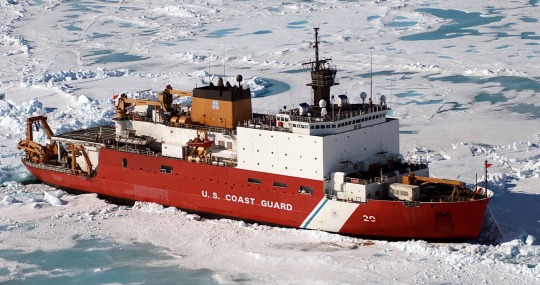
U.S. Coast Guard Cutter Healy (WAGB-20) sits approximately 100 miles north of Barrow, Alaska, in order to conduct scientific ice research. © Wikipedia/U.S. Coast Guard/DoD
Besides that are three smaller icebreakers used by the National Science Foundation, an independence federal agency engaged in research into all non-medical fields of science. Its ships, built in the 1990s and mid-2010s, include the Nathaniel B Palmer, the RV Laurence M. Gould and the RV Sikuliaq. These vessels operate comfortably in between 0.3 (the Gould) and 0.75 meters (the Sikuliaq) of ice. The Gould and the Palmer are typically stationed in Antarctic waters, while the Sikuliaq, an indigenous word meaning ‘young sea ice’, operates off Alaska.
The Coast Guard has ambitious plans for expansion, expecting to get three new heavy icebreakers, and three medium ones, in the coming years and decades. Delivery of the first ship of the new fleet has been delayed from 2024 until at least 2027, with the service requesting $125 million for the purchase and modification of a commercially available polar icebreaker built in the USA to bridge the gap as the flagship Polar Star rapidly approaches the 50-years-old mark.
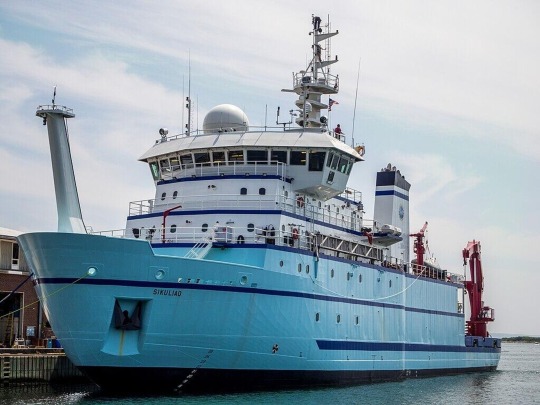
Icebreaking research vessel Sikuliaq in Woods Hole, Massachusetts. © Photo: James Buchanan
#4: Sweden 🇸🇪
Sweden, which does not have direct access to the Arctic from its coast, or any maritime territory above the Arctic Circle, nonetheless maintains an impressive fleet of icebreakers, mostly for patrolling the northernmost waters of the Gulf of Bothnia and in at least one case, a large inland lake. Sweden operates up to seven icebreakers, five of them – the Ale, the Atle, the Frej, the Oden and the Ymer, run by the Swedish Maritime Administration. The Ale is a 1,540 ton escort icebreaker, purpose built in the 1970s to sail in Lake Vanern, situated in southern Sweden about 150 km southeast of the border with Norway.

Sweden's Oden icebreaker pictured breaking up thick ice. © Photo: Swedish Maritime Administration.
The Atle, Frej and Ymer are Atle class icebreakers, built at the legendary Wartsila Helsinki Shipyard in Finland between 1974 and 1977. These ships are 104.5 meters long and displace 9,500 tons, and feature a dual rudder and dual bow propeller system that can crack ice at thicknesses of between 0.75 and 1 meters. The newest ship in Sweden’s icebreaker fleet is the Oden, a research vessel built in 1988 and originally tasked with escorting commercial vessels. The ship displaces up to 13,000 tons, and can power through ice up to 5 meters thick, with enough capacity to spare for operations in Arctic waters, pending supply support from a friend in the region. Sweden plans to built at least three new icebreakers, with the first expected to be delivered in 2027 at the earliest.
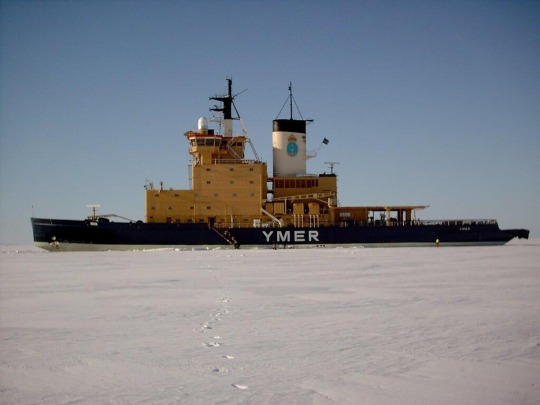
Sweden's Ymer icebreaker. © Photo: Marcus Bengtsson
#3: Finland 🇫🇮
Finland’s icebreaker fleet packs a surprisingly strong punch, facilitated by the country’s northern geography, and decades of successful shipbuilding cooperation and sales to its neighbors, Sweden and Russia. The country’s fleet, which includes nine major icebreaking ships, plus one icebreaking-capable special-use ship operated by the Navy, includes the oldest ships in this list: The Voima, commissioned all the way back in 1954, and refit in the late 1970s and again in 2016, is classed as an 1A Super icebreaker, enabling it to break up sea ice up to 1.2 meters thick at speeds of 2 knots.
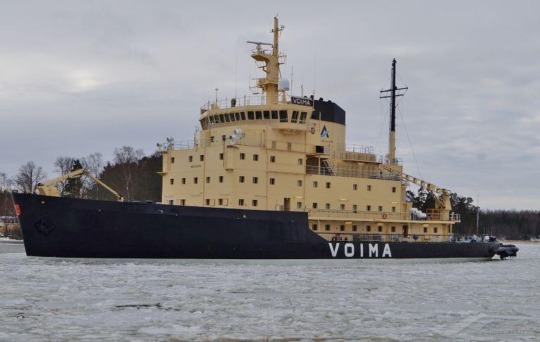
The Voima icebreaker, one of the oldest known icebreakers in operation. © Photo: Pekka Jarvinen
The Urho and Otso-class (two ships each) displace 9,660 tons and 9,222 tons, respectively, and were built in the 1970s and 1980s to operate in Gulf of Bothnia and Gulf of Finland waters, where ice can reach up to 45 cm thick during winter. The Navy-operated ship is called the Louhi, is owned by the Finnish Environmental Institute, and is classified as an oil and chemical spill response vessel. The ship has a 3,450-ton displacement, and can penetrate ice ridges up to an impressive 5 meters thick, while operating at speeds up to 9.5 knots in 1-meter thick ice.
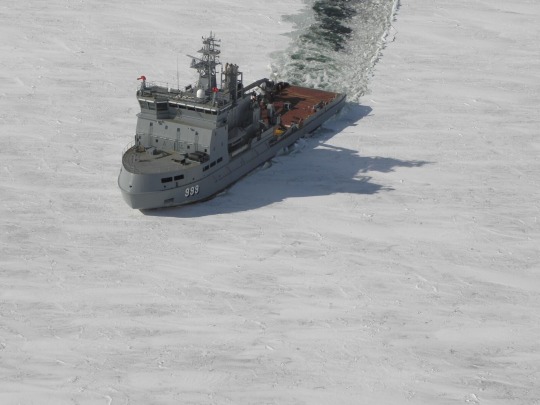
The Louhi, a unique Finnish multipurpose vessel design by ILS Oy Ship Design & Engineering with impressive icebreaking capabilities. © Photo: ILS Oy Ship Design & Engineering
#2: Canada 🍁 🇨🇦
Canada, Russia’s Arctic neighbor to the north, has an Arctic coastline stretching a whopping 162,000 kilometers thanks to 94 major and 36,400+ minor islands covering a territory of some 1.4 million square kilometers. That makes a large and diverse icebreaker fleet essential for assuring the country’s sovereign claims. Canada’s Coast Guard operates at least 15 icebreakers (about half of them capable of operations in the far north), at least three icebreaker/tug/supply vessels purchased from Sweden, and two offshore patrol vessels with icebreaking capabilities operated by the Navy.
The flagship of Canada’s icebreaking fleet is the Louis S. St-Laurent, a massive, 15,324 ton heavy icebreaker commissioned in 1969 and undergoing refits in the late 1980s and 2000, with room for two Bell 429 helicopters onboard and enough space to comfortably supply 46 crew for over 6 months at a time. The ship can break through ice between three and five meters thick, with its ice horn designed to protect the rudder.

Top: Louis S. St-Laurent, the flagship and pride of the Canadian Coast Guard's icebreaker fleet. © Photo: Serg Tremblay Bottom: HMCS Harry DeWolf on patrol in Dutch Harbor, September 2021. © Photo: US Coast Guard
Other prominent vessels in the fleet include four ships of the Pierre Radisson-class of medium icebreakers, which weigh 8,180 tons fully loaded and can plow through ice a meter thick at speeds up to 6 knots, and the Martha L. Black class – featuring six light icebreakers built in the 1980s weighing about 4,740 tons full load, and operating off British Columbia, Quebec, Newfoundland and Labrador, and Nova Scotia.
The Canadian Navy’s icebreaking-capable warships including the HMCS Harry DeWolf and the HMCS Margaret Brooke, which can slash through first-year sea ice up to 120 centimeters thick.
#1 Russia 🇷🇺
Dwarfing the rest of the countries in this list, with more icebreakers than the rest of the planet put together, is Russia, whose fleet includes about 45 large icebreakers (seven of them nuclear-powered), well over a dozen off-shore icebreaking anchor-handling tug supply vessels, at least seven icebreaking-capable warships, and three research and survey vessels.
The nuclear-powered portion of the fleet includes the Yamal, the 50 Let Pobedy, the Taymyr, the Vaygach, and the brand new Project 22220 series Arktika, Sibir and Ural vessels, which were commissioned in 2020, 2021 and 2022, respectively (the fourth ship, the Yakutiya is set to join them this year, while the Chukotka, Leningrad and Stalingrad are expected by 2030). These massive, 173.3 meter-long ships have a complement of 75, helideck and hangar, and are propelled by two RITM-200 175 MWt-apiece nuclear reactors and twin turbo generators, allowing them to accelerate to speeds of up to 22 knots through open waters, or 1.5-2 knots in ice 2.8 meters thick (with the ability to operate in ice up to 4 meters thick at slower speeds).

Top: Russia's Arktika-series nuclear-powered icebreaker being pulled along by tugs in a shipyard. © Sputnik/Aleksander Galperin/Go to the mediabank Bottom: Project 21900M diesel-electric icebreaker Novorossiysk in the harbor in Murmansk. © Sputnik/Pavel Lvov
Russia owes its nuclear icebreaking prowess to the Lenin, the world’s first nuclear-powered icebreaker, commissioned in 1959 and turned into a museum ship permanently docked in Murmansk in 1989.
An even larger icebreaker, the Project 10510 Rossiya, which is 219 meters long and displaces nearly 70,000 tons, will be able to crack through 4-meter thick ice with ease, and leave a large, 47.7 meter-wide path for any ships it happens to be escorting. The ship’s 127-person crew will be able to operate non-stop for up to 8 months at a time, enough to ensure comfortable year-round for operations through Russia’s Northern Sea Route passage.
Diesel-powered ships in the Russian icebreaking fleet include the Admiral Makarov, a veteran scientific and supply ship commissioned in 1975, seven ships total of the Kapitan Sorokin and Mudyug-class icebreakers built for the USSR by Finland in the 1970s and 1980s, and the new Project 21900 ships, the Moskva and the Sankt-Peterburg, built in 2008 and 2009, respectively. The latter displace 14,300 tons, and crack through ice up to 1.5 meters. A modernized model of the Project 21900, Project 21900M, has been built from 2015 onward, and includes the Vladivostok, Murmansk and Novorossiysk. Two more, the Arkhangelsk and the Vyborg, are on the way and may be delivered as soon as this year.

Top: The new generation diesel-electric icebreaker Ilya Muromets being launched into the water from its drydock. © Sputnik/Igor Russak/Go to the Mediabank
The Russian Navy’s complement of icebreakers includes the Ilya Muromets, a 6,000 ton-displacement vessel commissioned in 2017 featuring a unique contra-rotating propeller design, and the Evpatiy Kolovrat, which displaces 4,080 tons, and is expected to be commissioned by the Pacific Fleet later this year. The ships are expected to facilitate naval operations in ice up to 1.5 meters thick.
Finally yet importantly are Russia’s active icebreaking research ships, the Mikhail Somev, Akademik Fedorov and Akademik Tryoshnikov, built between the mid-1970s and the early 2010s. These vessels are between 133.5 and 141 meters long, displace between 16,200-16,500 tons, and are classed for independent operations through ice between 1.4 and 3.2 meters thick. Scientists the world over owe much of our fundamental knowledge about the most remote regions of the Arctic and Antarctic to Soviet and Russian icebreaking research ship technology, and to the many thousands of researchers and scholars who have worked aboard them over the decades.
— Ilya Tsukanov | Sputnik International | Sunday February 11, 2024
#World 🌎 | Russia 🇷🇺 | Sweden 🇸🇪 | Arctic 🐻❄️ 🥶 | Coast Guard | Navy#United Nations Convention on the Law of the Sea (UNCLOS) USCGC Healy | Sibir | Finland 🇫🇮 | US 🇺🇸#Icebreaker#Canada 🍁 🇨🇦
0 notes
Video
undefined
tumblr
Equipment belonging to the US Army 🇺🇸 3rd Armored Brigade Combat Team, 1st Cavalry Division staged at the Port of Gdynia, Poland 🇵🇱 in preparation for redeployment to the continental United States after serving in the Operation Atlantic Resolve, Feb. 22, 2023.
1 note
·
View note
Photo

INDEPENDENCIA DE ESTADOS UNIDOS DE AMÉRICA 🇺🇸 El Día de la Independencia de los Estados Unidos (Independence Day o The Fourth of July en inglés) es el día de fiesta nacional que se celebra el 4 de julio en los Estados Unidos. Este día marca la firma de la Declaración de Independencia en 1776 en la cual el país proclamó su separación formal del Imperio británico. Usualmente se celebra con muchas actividades al aire libre como desfiles, partidos de béisbol y espectáculos de fuegos artificiales. Es la fecha tradicional de varias carreras automovilísticas, entre ellas las Firecracker 400 de la NASCAR Cup Series en Daytona, el Gran Premio de Cleveland de la serie Champ Car y el Gran Premio de Watkins Glen de la IndyCar Series. Durante la independencia estadounidense, la separación jurídica de las Trece Colonias de Gran Bretaña ocurrió el 2 de julio de 1776, cuando el Segundo Congreso Continental votó para aprobar una resolución de independencia que había sido propuesta en junio por Richard Henry Lee de Virginia declarando los Estados Unidosindependizados de Gran Bretaña. Después de votar a favor de la independencia, el Congreso centró su atención en la Declaración de Independencia, una declaración explicando esta decisión, que había sido preparada por un comité de cinco, con Thomas Jefferson como su autor principal. El Congreso debatió y revisó el texto de la Declaración, finalmente aprobándola el 4 de julio. #4dejulio #fourthofjuly #diadelaindependencia #independentday #usa🇺🇸 #arziade (at United States of America) https://www.instagram.com/p/Cfloe7FOrql/?igshid=NGJjMDIxMWI=
0 notes
Text

Today is Flag Day🇺🇸
Flag day celebrates the day in 1777 when the United States approved the design for our first flag. The Second Continental Congress declared the American flag would have 13 stripes of red and white, and 13 white stars in a field of blue. June 14th was officially declared a holiday by President Woodrow Wilson in 1916. There have been 27 official versions of our flag. The last change was made on July 4, 1960 when Hawaii became our 50th state.
According to reports, the Congress of the Articles of Confederation chose the colors for the Great Seal of the United States with these meanings:
Red for valor and hardiness
White for purity and innocence
Blue for vigilance, perseverance and justice
Happy Flag Day! 🇺🇸❤️🤍💙🇺🇸
24 notes
·
View notes
Photo

🇺🇸247 Years old on June 14, 1775, the Continental Army🇺🇸, Forerunner of the United States Army🇺🇸, was Created🇺🇸 https://www.instagram.com/p/Cey8VN5FaEIswzNoIF1uf7NBbuuelEOajIFOqc0/?igshid=NGJjMDIxMWI=
10 notes
·
View notes
Photo

Reposted from @the9stripes In the early days of the American Revolution, before the formation of the Continental Army, several colonial regiments and local militias were engaged against the British. Each local group flew their own colors in battle. On June 14 1777, the Second Continental Congress passed a resolution stating that “the flag of the United States be 13 stripes alternating red & white” and that “the union be 13 stars of white in a blue field representing a new constellation”. This was the original ‘Betsy Ross’ design. Two generations later President Woodrow Wilson declared June 14 a national holiday to commemorate the birth of Old Glory, the American Flag. Happy Flag Day! #flagday #flagday🇺🇸 #history #americanrevolution #donttreadonme #appealtoheaven #joinordie #georgewashington #betsyross #reaisttyranny #minutemen #moderndayminuteman #americanexceptionalism #communismkills #freedom #liberty #thepursuitofhappiness #wevegotacountrytosave (at United States) https://www.instagram.com/p/CezFx1AFCz0/?igshid=NGJjMDIxMWI=
#flagday#flagday🇺🇸#history#americanrevolution#donttreadonme#appealtoheaven#joinordie#georgewashington#betsyross#reaisttyranny#minutemen#moderndayminuteman#americanexceptionalism#communismkills#freedom#liberty#thepursuitofhappiness#wevegotacountrytosave
0 notes